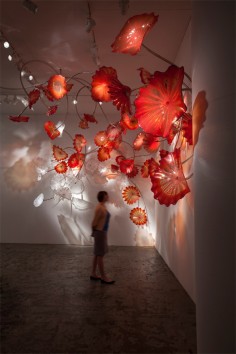DALE CHIHULY
Дейл Чихули

source: kaiaktw
美國玻璃藝術家 Dale Chihuly 進行玻璃創作超過 40 年,他的技巧以及作品讓人驚嘆,漩渦、球體、花卉甚至是海洋生物等不同題材創作在世界各地展出。這系列名為〝Chelsea Persians〞的裝置藝術創作於 2006 年在紐約第一次展出,以手工吹製創作出開放式圓盤狀與條文形式的玻璃,搭配曲線的不鏽鋼骨架大幅度的跨越牆壁與天花板,將整個展示空間點綴得如夢似幻。Dale Chihuly 表示,他一直致力於探討藝術作品如何與建築空間結合,研究如何將精力與注意力集中在一個房間。因為人為與自然的光線透過有色的玻璃,以稜鏡式反應在內部空間,形成了神奇的光彩!
.
.
.
.
.
.
.
source: kulturologiaru
Вот уже больше 50 лет Дейл Чихули (Dale Chihuly), американский художник со словацкими корнями, талантливый стеклодув, автор удивительных изваяний из разноцветного стекла, радует нас своими шедеврами. Выставки по всему миру, музеи и галереи, инсталляции и авторские арт-проекты, все это выглядит таким небыкновенным, что кажется, будто автор создает сказку. Хрупкую, изящную, стеклянную.
Этого чародея с его стеклянными сказочными мирами знают во всем мире: никто другой не славится такой фактурностью и сложностью работ, глубиной цвета и разнообразием форм причудливых скульптур. Они напоминают морские раковины, листья и лепестки диковинных заморских растений, сюрреалистические люстры и другие объекты, не поддающиеся однозначному описанию. Кажется, что автор нарочно нарушает существующие нормы и правила, регулирующие подобного рода творчество. Но его игра стоит свеч, о чем свидетельствуют слава, признание и популярность, которыми он буквально окутан со всех сторон, причем уже на протяжении многих лет.
.
.
.
.
.
.
.
source: designrulz
Born in 1941 in Tacoma, Washington, Dale Chihuly was introduced to glass while studying interior design at the University of Washington. After graduating in 1965, Chihuly enrolled in the first glass program in the country, at the University of Wisconsin. He continued his studies at the Rhode Island School of Design (RISD), where he later established the glass program and taught for more than a decade. Mark McDonnell wrote about the artist: “Chihuly has observed, and remains true to the fact, that glass is one of the few materials that transmit light and radiate color. Constantly experimenting with the properties and potential of his material, he has developed an extended and novel palette with a broad range and complexity at precisely the moment that color field painting seems to be in decline.”
His material is glass, which is traditionally associated with the decorative arts, by definition subservient to architecture, and with closed vessels and containers or precious small-scale objects. Yet Chihuly has broken through these limitations and literally changed the definition of glass.
He has found ways of creating huge environments and theatrical happenings with this intransigent and fragile material by stretching its unique properties in unprecedented ways.
Barbara Rose wrote about the artist’s projects: “Chihuly’s shimmering glass installations create the pleasure and release of a bodily freedom that permits us to feel unanchored, liberated both from gravity and from the familiar boring and colorless shapes and experiences of everyday reality.”
Like many artists with roots in the sixties, Chihuly works in series and uses permutations to add variety. The step from hard to soft cylinders was an obvious one to take next.
.
.
.
.
.
.
.
source: chihuly
Born in 1941 in Tacoma, Washington, Dale Chihuly was introduced to glass while studying interior design at the University of Washington. After graduating in 1965, Chihuly enrolled in the first glass program in the country, at the University of Wisconsin. He continued his studies at the Rhode Island School of Design (RISD), where he later established the glass program and taught for more than a decade.
In 1968, after receiving a Fulbright Fellowship, he went to work at the Venini glass factory in Venice. There he observed the team approach to blowing glass, which is critical to the way he works today. In 1971, Chihuly cofounded Pilchuck Glass School in Washington State. With this international glass center, Chihuly has led the avant-garde in the development of glass as a fine art.
His work is included in more than 200 museum collections worldwide. He has been the recipient of many awards, including twelve honorary doctorates and two fellowships from the National Endowment for the Arts.
Chihuly has created more than a dozen well-known series of works, among them, Cylinders and Baskets in the 1970s; Seaforms, Macchia, Venetians, and Persians in the 1980s; Niijima Floats and Chandeliers in the 1990s; and Fiori in the 2000s. He is also celebrated for large architectural installations. In 1986, he was honored with a solo exhibition, Dale Chihuly objets de verre, at the Musée des Arts Décoratifs, Palais du Louvre, in Paris. In 1995, he began Chihuly Over Venice, for which he created sculptures at glass factories in Finland, Ireland, and Mexico, then installed them over the canals and piazzas of Venice.
In 1999, Chihuly started an ambitious exhibition, Chihuly in the Light of Jerusalem; more than 1 million visitors attended the Tower of David Museum to view his installations. In 2001, the Victoria and Albert Museum in London curated the exhibition Chihuly at the V&A. Chihuly’s lifelong fascination for glasshouses has grown into a series of exhibitions within botanical settings. His Garden Cycle began in 2001 at the Garfield Park Conservatory in Chicago. Chihuly exhibited at the Royal Botanic Gardens, Kew, near London, in 2005. Other major exhibition venues include the de Young Museum in San Francisco, in 2008; the Museum of Fine Arts, Boston, in 2011; and the Montreal Museum of Fine Arts in 2013. Chihuly Garden and Glass, a long-term exhibition, opened at Seattle Center in 2012.

